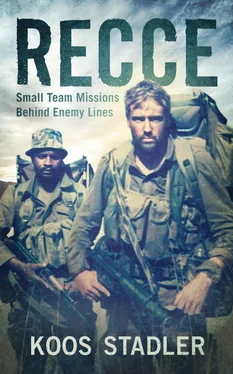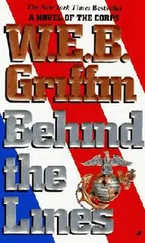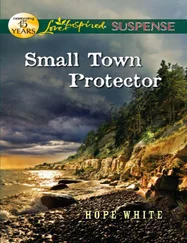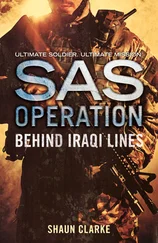While these targets were tactically almost insignificant, their destruction would signal to the ANC and their hosts that the South African government could get to the freedom fighters wherever they were harboured. A secondary task for all the deployments was to bring out as much intelligence material as possible, either in the form of propaganda pamphlets or actual operational planning documents.
Our rehearsals were conducted at the General Piet Joubert Training Area at Murray Hill, north of Pretoria. One of the old farmhouses had been converted to resemble 29 Eves Crescent, and we acted out every possible scenario in approaching, attacking and clearing the facility. Jo-Jo and his two teammates rehearsed at Special Forces HQ where they could place their ladder and practice the entry drills into the second floor.
Finally the teams were ready, and we were flown to Alldays by helicopter on the afternoon of 18 May 1986. The forces that would conduct the operations in Botswana and Zambia reported that they were ready, and we departed from Alldays in two Pumas just before last light. The pilots flew nap-of-the-earth (below radar coverage) wearing night-vision goggles, a scary experience if you are a passenger looking out in the darkness at the ground rushing by. Agents from D-40, the highly secretive and covert military unit, awaited us at a prepared LZ in the area of Gwanda in Zimbabwe. From here we drove in a dilapidated old kombi to a deserted farm in the Matopo Hills, where we spent the next day preparing our kit and sorting out final details with the agents.
The D-40 operatives hired four vehicles from Avis in Harare to take the teams to their targets. Diedies had decided that the team leaders needed to drive by their targets to assess the situation first-hand, so a final recce was organised with the guys from D-40, while Diedies checked out the area where the mission HQ would be established, a hill close to Heroes’ Acre in the centre of town. That afternoon the teams departed from the lying-up place and drove to Harare to meet Diedies and the team leaders at Lake Chivero, our predetermined assembly point outside the city.
Bill filled us in on the situation at the target: while he didn’t see any enemy, the house had a high wall in front and the gates were locked with a padlock. The front yard was brightly lit and two large dogs were seen inside. Jo-Jo reported to his team that, while the office block appeared to be quiet, the street in front was abuzz with people from a number of hotels and bars in the area.
By 21:00 Diedies and the team doctor departed to take up their mission command post at Heroes’ Acre. Just after midnight the teams started moving in on their respective targets in the hired vehicles. The infiltration went smoothly. We stopped just outside the gate at 29 Eves Crescent and jumped the wall using a short aluminium ladder. I immediately went around the right side of the house, while Bill and the assault element engaged the main building. One operator was assigned to cut the lock on the gate as soon as we were inside, to ensure a quick getaway, and the two dogs saw this as an ideal opportunity to opt out of the fight and take flight down the street.
On the side of the house I ran into an unforeseen obstacle, a makeshift fence that barred our entry. It took two of us to charge it down, and we literally fell in on the target. I jumped up and engaged the outbuildings, lobbing a stun grenade into the room and adjacent bathroom, but then my MP5 jammed after the first shot. I cocked and engaged again, but once again it had a stoppage. I quickly went down on my knees and changed magazines, cocked and fired into the dust-filled rooms.
By this time everyone had switched to white light on the weapons (by means of a powerful torch mounted below the barrel), as was the drill upon first engagement. I swept the outer room and bathroom with my torch and realised that they were empty, aside from stacks of ANC pamphlets spread out on a table. These I quickly collected in a bag each of us carried for this purpose, and then took up position outside with my teammate.
In the meantime Bill and the rest of the main assault team had followed us round and entered the house through the rear door, having found that the front was too strongly secured for a quick entry. The team encountered minor resistance inside, as there appeared to be only one person guarding the place. The house was cleared in a matter of seconds, and the piles of documents and propaganda material were hastily thrown into the plastic bags. Bill coordinated the setting of 4-kg charges in the house and the outbuildings, and on his command we initiated the timers. In less than two minutes the assault was over and the charges armed. Everyone cleared the house and got into the vehicles outside. We were barely two blocks away when the charges detonated. Twice we passed police vehicles flashing by in the opposite direction, but we reached the RV safely and waited for Diedies and Jo-Jo to arrive.
At the Angwa Street target the team found the street as busy as earlier that night. When they pulled their minibus (one of our hired vehicles) into a parking lot in front of the building, a security guard armed with a knobkierie ordered them away, apparently because the parking was reserved for police vehicles. When Vic told him to move aside, the guard became quite agitated and started shouting and threatening. Vic then produced his AK, which finally convinced the guy that he should rather stand down.
Jo-Jo’s teammates placed the ladder and held it down while he quickly mounted to the second floor. The burglar-proofing posed a minor obstacle, but Jo-Jo managed to get the charges inside and armed the devices through the window. The job was done in less than a minute and the team got away safely. The ladder was left against the building and was on display for the world’s media the next day.
All elements made it safely to the RV and we departed in a convoy towards the pick-up point in the Ngezi Recreational Park, south of Harare. A few kilometres from the city, a car overtook us from behind. The driver, a white man, inspected us as he drove past, then sped ahead and made a U-turn in the road, passing us again on his way back to Harare. We found this curious, but encountered no further obstacles on our route. Twice we stopped to strew the road with caltrops – multi-spiked metal “thorns” that would puncture any vehicle’s tyres and delay a pursuit.
There was a thick fog in the area of our pick-up point, to the extent that we feared the helicopters might not be able to locate our strobes or make a safe landing. We offloaded our gear from the vehicles and prepared an LZ while the drivers wiped the vehicles clean of fingerprints. Finally, at first light we heard the lead pilot calling on the radio, and soon the noise of the aircraft became audible. The fog had lifted slightly and the helicopters were able to land and get us out of there. The cars were left at Ngezi but a call was made to the Avis office in Harare to thank them cordially and inform them where they could find their vehicles.
While the three raids conducted simultaneously in Harare, Gaborone and Lusaka had little tactical impact, the political fallout was huge. South Africa was once again criticised by Western powers and African nations alike for its apartheid policies and its “flagrant acts of war” against its neighbours. The effect the raids had on the ANC was impossible to measure, although I believe that the message was conveyed that the South African Defence Force would strike at its enemies wherever they were hiding.
5
Operation Colosseum
October-November 1986
“In comradeship is danger countered best.”
– Johann Wolfgang von Goethe (1749–1832)
ON 25 OCTOBER 1986 the whole of 5 Recce converged on Oshivelo, a training area adjacent to the northern tip of the Etosha National Park. It was just across the so-called red line, dividing the farmlands to the south from the operational area to the north. The unit had come together to rehearse for Operation Colosseum – a deep penetration into Angola for a base attack on the headquarters of SWAPO’s Eastern Front. A two-man recce team – José da Costa and I – would be inserted a week before the attack to locate the base and call in the attack force. This was to be our first Small Team deployment together, and both of us were a bit apprehensive, as each of us was unsure what to expect of the other.
Читать дальше












